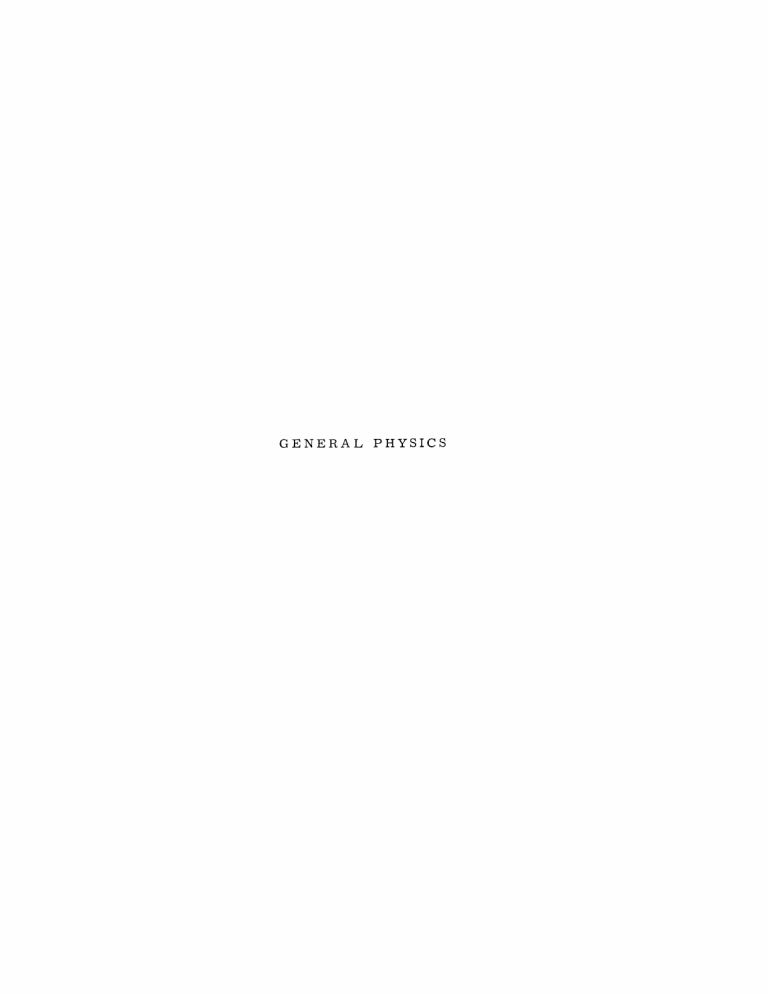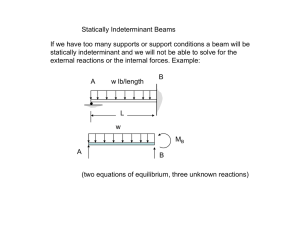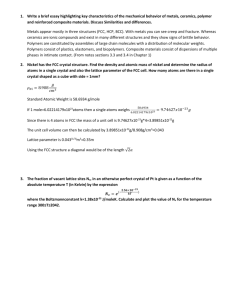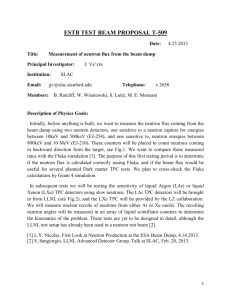GENERAL PHYSICS

GENERAL PHYSICS
I. MOLECULAR BEAMS*
Academic and Research Staff
Prof. J. R. Zacharias
Prof. K. W. Billman
Prof. J. G. King
Prof. C. L. Searle
Prof. E. F. Taylor
J. F. Brenner
R. Golub
Graduate Students
G. L. Guttrich
W. D. Johnston, Jr.
S. G. Kukolich
F. J. O'Brien
M. A. Yaffee
C. O. Thornburg, Jr.
L. H. Veneklasen
A. NEUTRALITY OF THE NEUTRON
An experiment has been undertaken to examine more closely the limit that may be placed on a possible charge possessed by the free neutron. The implications associated with such a charge are numerous. A neutron charge of approximately 2
X 1018 electron
1 charge (e) would explain the expanding universe on the basis of electrostatic repulsion.
A neutron charge of approximately 2. 5 X 10-19 e would explain the magnetic fields of the earth and sun.2 Finally, the independence of three conservation laws
Conservation of Baryons, Conservation of Leptons, and Conservation of Charge
is linked to the strict neutrality of the neutron and the equality of the magnitude of the electron and proton charges.
The experimental technique employed here was to subject a beam of neutrons to a strong, uniform, transverse electric field, E.
If the neutrons are assumed to possess a charge q, this would result .in an angular deflection of the beam
0 =
Eq L m v
2
(1) for small 0. Here, m is the neutron mass, L is the length of the deflection region, and v is the longitudinal beam velocity. Reversing the sense of E would give rise to a deflection -0; that is, upon field reversal an angular charge of AO
= 20 would be expected.
Thus the charge measurement reduces to the detection of small angular beam deflections.
Figure I-1 illustrates schematically the technique that was used.
A beam of heavywater-moderated neutrons from the M. I. T. reactor, operating between power levels of
2 to 5 Mwatts during the experiment, impinge on a perfect Si crystal with a flux of approximately 109 neutrons/second. This monochromating crystal Bragg reflects the desired neutrons of wavelength X = 2. 40 A with a scattering angle of 45" onto the second analyzer Si crystal. When the analyzer crystal is correctly adjusted, the neutrons are
This work was supported by the Joint Services Electronics Programs (U. S. Army,
U. S. Navy, and U. S. Air Force) under Contract DA 36-039-AMC-03200(E).
QPR No. 82
(I. MOLECULAR BEAMS) reflected into the conventional BF
3 detector and counting system. It should be noted that another, "contamination" wavelength of X/3 = 0. 8 A is also reflected. Its effect was r -- S,
SHIELD
MONOCHROMATING
XTAL
-COLLIMATOR SLIT
SWITCH,
PRINTER
COUNTER
I
+V
+V
*.-o
VI
AMPLIFIER
HIGH VOLTAGE
HIGH VOLTAGE
(1=150cm,d=0.2cm,h=4cm)
I
-TRAPS 8 PUMPS i
'(11) n"ANALYZING XTAL
BF GAS DETECTOR
AND PRE-AMPLIFIER
I
Fig. I-i. Schematic diagram of the neutron-neutrality experiment.
carefully measured and accounted for, and thus will not be mentioned in the sequel. Two boron-enriched slits limit the beam width so as to avoid reflection of the neutrons from the high-voltage electrodes. The absence of such reflections was carefully determined.
The counting rate is an extremely sensitive function of the angle of incidence of the beam onto the analyzer. By providing a unique mounting for this crystal, and by carefully maintaining the apparatus in a constant temperature environment, sufficient stability was obtained to use the change in counting rate to detect a beam deflection when the transverse electric field was applied. The field was provided by the parallel-plate electrode structure shown in Fig. I-1. The construction and support were consistent with providing negligible gradients to the beam and to maintaining constant field magnitude when the electric field was reversed by means of the reversing switch. The entire electrode assembly was contained in a vacuum system, the neutron beam entering and leaving through thin aluminum windows.
Under the assumption that the neutrons did possess a charge of, say, +10
- 17 e, the angular deflection of the beam for this geometry would amount to ±2 msec of arc when an electric field of ±200 volts/cm was provided. Hence, as the electric field was automatically reversed at 5-min intervals, the angle of incidence of the beam onto the analyzer crystal would vary by this amount around some zero-field value, o .
Figure I-2 shows a typical "rocking curve" of this double crystal arrangement; that is, the effect of varying the angle of incidence of the neutron beam onto the analyzer
QPR No. 82
(I. MOLECULAR BEAMS) crystal. This curve was actually obtained with the high-voltage electrode system in position, but with E = 0, and by rotation of the analyzer. From the slope of the curve in the region of O6, the sensitivity of a __ the experimental arrangement can be
C
300 X2.40A
Si (il) 2-Mw REACTOR
POWER LEVEL assessed. For low power level operation of the reactor, this was typically
E
200 z
-
C 100
S.
0
..
"4.1 sec
75 n/min-sec of arc, and for high power level it was 200 n/min-sec of arc. The theoretical limit to the half-width of the rocking curve can be shown from
..
-4 -2 0 2 4
ROCKING ANGLE (seconds of arc) diffraction theory to be
Mbk
2 rr sin 20
Fig. 1-2. Typical rocking curve of the double-crystal spectrometer. where M is the atomic density of the crystal, b is the crystal structure factor, X is the neutron wavelength, and 0 is the Bragg angle.
For the arrangement used here a theoretical 6 of 3. 2 sec is predicted, whereas an excellent value of 4. 1 sec was attained.
A verification of the equivalence of using this rocking curve for the basis of the sensitivity to beam deflection was made. The beam was actually deflected by positioning an aluminum prism in the beam in the region between the two crystals. If the prism angle is a, the corresponding angular deviation of the beam can be shown to be
= 2(l-n) tan a =
Mbk
2
2 tan a, (3) where n is the index of refraction, M the atomic density, and b the absolute scattering amplitude of aluminum. It should be noted that such a deflection is fully equivalent to a neutron charge deflection in its wavelength dependence, as can be seen from Eq. 1 when h the de Broglie relation v = h is used to eliminate the velocity. Figure I-3 shows the agreement obtained between the change in angular deflection of the beam as the aluminum prism was rotated 1800, as predicted by Eq. 3, and that computed from the measured change in neutron count rate and the corresponding angular charge ascertained from the rocking curve.
The experimental results are exhibited in Fig. 1-4. The ordinate axis is the angular deflection, AI, to the field when on to the field turned off; that is, it is one half of the angular deflection change under reversal of the sense of the electric field. The error brackets are found to agree extremely well with those to be expected on the basis of
-n-.
For obvious reasons, much more data were accumulated at the highest value of the
QPR No. 82
(I. MOLECULAR BEAMS) o 60 -+
E z o cn r
8 SIDE
CALCULATED
ALUMINUM PRISM
DEFLECTION
(APEX 3.20) cn 0
0z -20
0
0L
-
S- SIDE
A
-- -- CALCULATED z -40 o m -60
-j
LL
Fig. I-3. Experimental verification of apparatus sensitivity as determined from the rocking curve.
U~
0
2-
+10
-
17
ELECTRON CHARGE
0- 0
H n -2
LEAST-SQUARES FIT q= (-2.0 +3.8) 10
ELECTRON CHARGE
-j
U-
E
-3
-4- r" -5
_j -6
0 100 200
-10
300 z DEFLECTING ELECTRIC FIELD (KILOVOLTS/cm)
Fig. 1-4. Experimental results.
electric field which could be attained. The dotted lines indicate what angular deflection would have been measured if the neutron charge were as large as ±10 -
17 e. A leastsquares fit gives (-2. 0± 3. 8)1018 e; that is, if the neutron does possess a charge, we dotted band illustrated in Fig. 1-4.
K. W. Billman, C. G. Skull, F. A. Wedgwood.
[Professor C. G. Skull and Dr. F. A. Wedgwood are at The Center for Materials Science and Engineering. This work was supported in part by the National Science Foundation]
QPR No. 82 4
(I. MOLECULAR BEAMS)
References
1. R. A. Lyttleton and H. Bondi, Proc. Roy. Soc. (London) A252, 313 (1959).
2. A. Piccard and E. Kessler, Arch. Sci. Phys. et Nat. (Geneva) 7, 340 (1925).
3. G. Feinberg and M. Goldhaber, Proc. Natl. Acad. Sci. U. S. 45, 1301 (1959).
QPR No. 82







